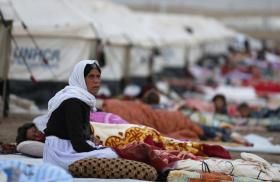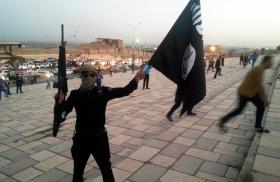
- Policy Analysis
- PolicyWatch 1519
Intelligence Transformation: Meeting New Challenges in the Middle East and Beyond

Part of a series: Counterterrorism Lecture Series
or see Part 1: U.S. Efforts against Terrorism Financing: A View from the Private Sector
An inside look at how the U.S. intelligence community has adapted to meet new threats in the Bush and Obama administrations.
On May 19, 2009, U.S. undersecretary of defense for intelligence James R. Clapper, Jr., addressed a special Policy Forum luncheon at The Washington Institute as part of a lecture series sponsored by the Stein Program on Counterterrorism and Intelligence. The U.S. Senate confirmed Mr. Clapper as undersecretary of defense for intelligence on April 11, 2007. He was asked by President Obama to stay on in this position in February 2009. The following is a rapporteur's summary of his remarks.
Download a complete transcript of Undersecretary Clapper's remarks (PDF).
It has been interesting to watch the transition from the Bush to the Obama administration. In the case of the Department of Defense (DOD), the changeover has been smooth and relatively painless, due largely to the unprecedented decision to have Robert Gates remain as secretary of defense and his rapid integration of new arrivals into the department.
The position of undersecretary of defense for intelligence -- created just four years ago -- is the newest of the five undersecretary positions in the Defense Department. The undersecretary's principal responsibility in this position is to oversee the intelligence agencies embedded in DOD: the National Security Agency (NSA), National Geospatial-Intelligence Agency (NGA), National Reconnaissance Office (NRO), and Defense Intelligence Agency (DIA). The undersecretary oversees the intelligence activities in each of the military services as well.
The undersecretary wears a "second hat" as director of defense intelligence for the director of national intelligence (DNI) -- an idea endorsed by then DNI Michael McConnell as well as Secretary Gates. The new DNI, Dennis Blair, has bought into the concept, allowing for a great deal of cooperative work, including joint attendance at weekly DNI staff meetings and joint testimony on Capitol Hill, streamlining coordination and communication. The DOD and the DNI are seeking further ways to enhance coordination and synchronization, since much of the intelligence community is embedded in the Department of Defense.
Intelligence gathering and dissemination have changed greatly in the last forty-six years, primarily because of advances in technology. For instance, in 1991, during Operation Desert Storm, the United States encountered great difficulty transferring the massive amounts of satellite imagery to the U.S. Central Command (CENTCOM) Area of Responsibility (AOR), much to the irritation of then CENTCOM commander Gen. Norman Schwarzkopf. Today, needed intelligence arrives in the AORs much more quickly.
Many aspects of the intelligence community today, including some investments and practices, are legacies of the Cold War era and anachronistic. In the Cold War's heyday, it was easy for the intelligence community to pinpoint potential targets, but difficult to "fix and finish." Nowadays, with the kind of targets being pursued, the antithesis is true. Today's targets are very elusive and therefore quite hard to find, yet once they are found, they are very easy to finish. This reality has a very profound effect on the way intelligence is done today.
DOD has been working closely with the DNI to set up an Afghanistan/Pakistan "mission manager" who will oversee the efforts of the intelligence community as the U.S. government pursues a new strategy in that region. One of the efforts commissioned by Secretary Gates, one that he has emphasized, is called the Intelligence-Surveillance-Reconnaissance (ISR) Task Force. The ISR is run by Air Force Lieutenant General Craig Koziol, who chairs a "matrix-managed" organization, the basic objective of which is to accelerate the acquisition, procurement, and fielding of ISR resources to augment U.S. combat forces. In fact, UAVs have become the staple in this "find-fix-finish" cycle as it is practiced in the CENTCOM AOR.
The success of ISR has created a voracious appetite among combat units for as much ISR as the industrial base can turn out. The United States is fielding a great many UAVs, such as Predators and Reapers, as well as manned aircraft, all of which have signal intelligence and a full-motion video capability. Originally, the objective was to phase in this ISR capability in Afghanistan as the number of U.S. troops grows over the next several months. But with the increased importance of ISR, the deployment schedule has been accelerated.
Additionally, it is important to address the role the combat support agencies play, specifically NSA, NGA, and DIA, all of which have a large ground presence in the theater. The wartime "ops tempo" over the last eight years in Afghanistan and Iraq, which has had such an impact on our military, has also applied to and been felt by the civilian defense agencies. The special operations communities are also playing a huge role, which was made very clear during a recent trip to Pakistan and Afghanistan on which the speaker was accompanied by Assistant Secretary Michael Vickers, the official responsible for special operations. This trip also highlighted that Afghanistan differs greatly from Iraq in political arrangements, size, terrain, and level of infrastructure, all of which make for a very challenging environment.
Afghanistan is a classic counterinsurgency campaign: the United States will win it on a village-by-village basis. The United States should not concentrate solely on special forces taking out high-value targets, the focus must also be on providing local security and the larger task of nation building. In Afghanistan, the old maxim about "all politics being local" applies.
The security situation in Pakistan's North West Frontier Province, and its capital, Peshawar, is also of great concern. The Pakistani army has engaged in the Swat valley, trying to regain the lost province, which is a good sign. Unfortunately, this, in turn, has generated a humanitarian crisis -- 1.7 million people have been displaced -- that the army is going to have to deal with. Nevertheless, it is also a good sign that Pakistan has just recently appointed the same general who ran the earthquake relief effort in 2005. Hopefully this appointment will facilitate the flow of humanitarian aid into the area particularly through nongovernmental organizations.
Another problem in the region is the Durand Line, which demarcates Afghanistan and Pakistan, yet has little meaning to local residents since it does not comport with tribal boundaries in the area. The U.S. objective in the region is to deter, defeat, destroy, and dismantle the militant sanctuaries, be they in Afghanistan or in Pakistan. However, Pakistan is very sensitive about U.S. intrusions into its territory. The United States should therefore remember and acknowledge that both countries are sovereign, political entities and try to "work around" the border issue.
This rapporteur's summary was prepared by Merve Demirel.





